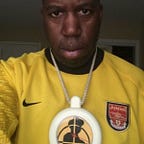Black Creativity and Exploitation: Swing
You may not have noticed. But there’s a “Korean Invasion” going on. A South Korean film, Parasite, did the improbable and won the 2020 Best Picture Oscar, Korean shows proliferate Amazon, and KPop groups are all over the airwaves (and on American Magazines — the band BTS graced the December 2020 issue of Esquire).
It’s not a coincidence.
South Korea has made a concerted effort to expand its cultural influence throughout the world. This focus is considered a nation using their soft powers. According to a recent report from the Korean Foundation for International Cultural Exchange (KOFICE), Korean’s Soft Powers accounted for $12.3B. As a result, the South Korean Ministry of Culture, Sports, and Tourism established a Hallyu-based department in May 2020.
Let’s look at how the Harvard Business Review defines power:
“At the most general level, power is the ability to influence the behavior of others to get the outcomes one wants. There are several ways to affect the behavior of others.
You can coerce them with threats.
You can induce them with payments.
Or you can attract or co-opt them.”
(Joseph S. Nye Jr., The Benefits of Soft Powers, 2004)
The first two bullet points, of course, are hard powers — the last, soft.
Whenever there’s uprisings like those that occurred in the summer of 2020, there’s always a select group of Black people that want a show of hard power in general, armed insurrection in particular.
We’ve discussed Coon & Race Music, this time we’ll be focusing on the breakout musical expression that came to be known as Jazz, specifically the Swing movement. In order to understand Swing, we’re going to have to talk about why it was popular and more importantly for this writing, the correlation with what we know as Hip-Hop.
When most people think of Swing, they envision preppy white folks like the ones seen in the Matt Ralston directed Gap commercial, “Khaki Swing” (1998). That commercial was the crescendo of an already growing trend. In the mid-90s young white people had rekindled a love for Swing. They started clubs. They started bands. They started contests. Then came that Gap commercial and the trend exploded all over the US.
Most of us Black people never mustered as much as a side eye.
That’s because we didn’t look at as our own. I first heard about what white folk call Swing Dancing (but we called Lindy Hopping) in the Autobiography of Malcolm X. In Chapter Four, Laura, Malcolm describes the dance like this:
‘Showtime’ people would start hollering about the last hour of the dance. Then a couple of dozen really wild couples would stay on the floor, the girls changing to low-white sneakers. The band now would really be blasting, and all the other dancers would form a clapping, shouting circle to watch that wild competition as it began, covering only a quarter or so of the ballroom floor. The band, the spectators and the dancers would be making the Roseland Ballroom feel like a big rocking ship. The spotlight would be turning, pink, yellow, green, and blue, picking up the couples lindy-hopping as if they had gone mad’.
The most famous dancers were Whitey’s Lindy Hoppers, a group of the best Harlem dancers assembled by Herbert ‘Whitey’ White.
White was a bouncer at the Savoy Ballroom in Harlem watching competition after competition. Finally he decided to put some of these dancers together in a group and Whitey’s Lindy Hoppers were born.
What makes White’s contribution stand out is his level of promotion. White took the Lindy Hop from Harlem to Hollywood where his dancers were featured in ten movies. This exposure increased the popularity of the Lindy Hop and made Swing music the de facto youth music of America.
A little over forty years later in 1983, Michael Holman would use a similar playbook. Holman combed New York City for the best b-boys and threw them together in a group he named The New York City Breakers. Holman then booked his dancers on TV shows, music videos, and movies (the New York City Breakers famously battled the Rock Steady Crew in Beat Street).
Holman even landed the New York City Breakers a gig on the Katherine Dunham Tribute at the 1983 Kennedy Center Honors ceremony. This exposure increased the popularity of Breaking, and made Rap music the de facto youth music of Black America. But we’ll get back to that.
Composers like Fletcher Henderson, Duke Ellington, and Chick Webb built a large following and a vast catalog of music that would become Jazz standards yet most of the accolades went to white bandleaders like Benny Goodman.
Nonetheless, Big Bands equaled big business and the US government wanted their share. On April 1, 1944 the Revenue Act of 1943 was enacted increasing cabaret taxes from 5% to 30%. This led to venues moving away from big bands. This coincided with the rise of bebop, smaller bands, jump blues and the end of Lindy Hopping. But only for a time.
The Honorable Elijah Muhammad often referred to us as a Nation inside of a Nation and described the power we had as a united front. One of the greatest powers we have is the power of influence, a Soft Power that can and does yield great profits….just not for us.
